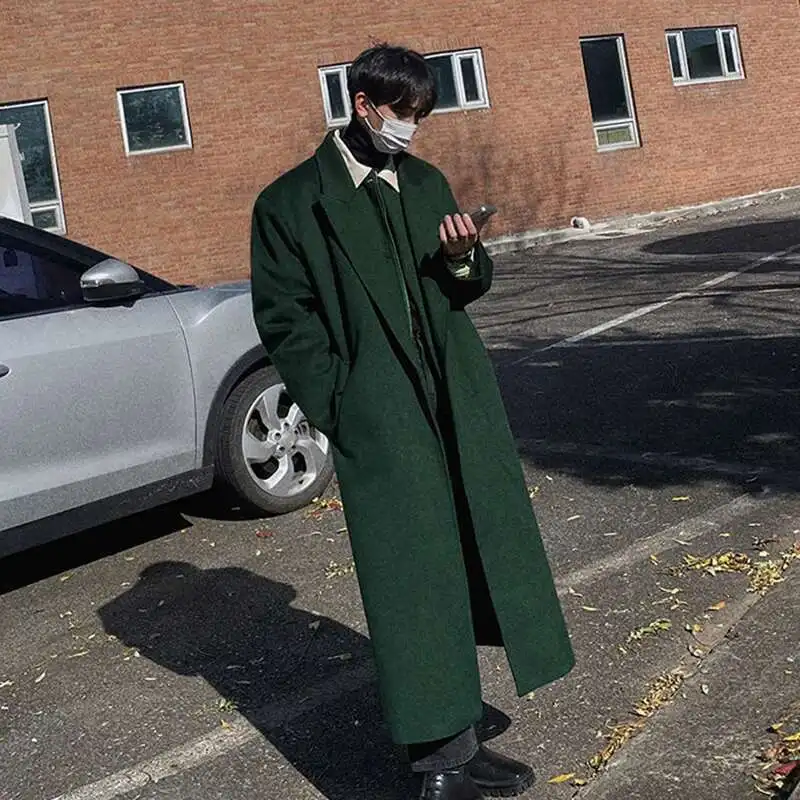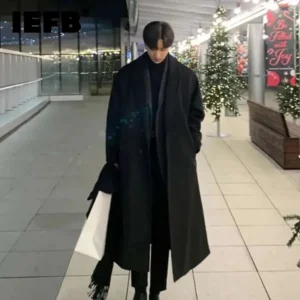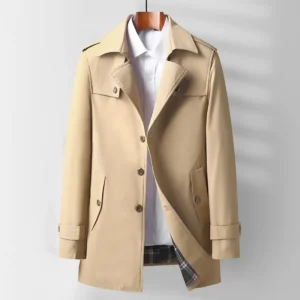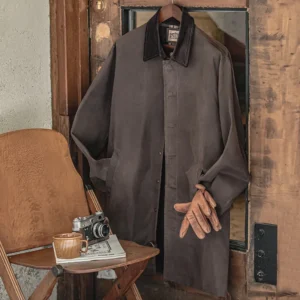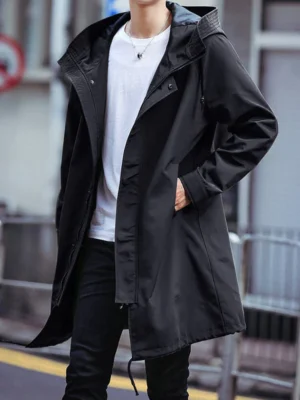The Timeless Appeal of Grey Overcoats in Everyday Fashion
A grey overcoat stands as perhaps the most versatile piece in men’s outerwear, effortlessly bridging the gap between formal elegance and practical everyday wear. Unlike its black counterparts that can sometimes feel overly formal, or colorful alternatives that limit outfit combinations, the grey overcoat serves as a neutral foundation that complements virtually any color palette in your wardrobe.
What makes grey overcoats particularly special is their transformative power. Even the most basic outfit—jeans and a simple sweater—gains immediate sophistication when topped with a well-fitted grey coat. This chameleon-like quality allows the same garment to elevate both your office attire and weekend casual wear with equal effectiveness.
The history of men’s grey overcoats spans centuries, with their silhouette evolving while their essential appeal remains unchanged. From military influences to modern minimalist designs, the grey overcoat has consistently represented a perfect balance of style and practicality. Fashion trends come and go, but this timeless piece maintains its relevance season after season.
When considering wardrobe investments, few pieces offer the lasting value of a quality grey overcoat. Unlike trendy pieces that quickly date, a well-chosen grey coat will serve faithfully for years, often becoming more characterful with age. This combination of versatility, elegance, and longevity makes finding the perfect daily grey overcoat a worthwhile pursuit for any style-conscious individual.
What “Daily Use” Really Means: Essential Qualities for a Practical Grey Overcoat
When we talk about an overcoat for “daily use,” we’re discussing something fundamentally different from special occasion outerwear. A coat designed for regular wear must balance several competing priorities that occasional-wear garments don’t need to address.
First and foremost, daily use demands durability. Your everyday overcoat will face constant stress from regular movement, varying weather conditions, and frequent putting on and taking off. It needs to withstand this consistent wear while maintaining its shape and appearance.
Comfort becomes non-negotiable for daily wear. Unlike a coat you might tolerate for a few hours at a formal event, your daily overcoat should feel like a welcome extension of your outfit—never restrictive or uncomfortable, even when worn for extended periods.
The perfect coat length plays a crucial role in daily practicality, affecting everything from how easily you can get in and out of cars to how protected you feel in inclement weather. This balance between protection and mobility represents one of the most important considerations for regular wear.
Versatility rounds out the essential qualities—a daily grey overcoat should pair effortlessly with most of your wardrobe, from business attire to casual weekend wear. This adaptability ensures you get maximum value from your investment.
In the sections that follow, we’ll explore each of these elements in detail, helping you identify the perfect grey overcoat that meets all your daily requirements.
Material Matters: Choosing Fabrics That Stand Up to Daily Wear
The fabric of your overcoat forms the foundation of its performance, directly impacting how it feels, how it drapes, how warm it keeps you, and how well it withstands regular use. For daily wear, this choice becomes even more critical.
Pure Wool: The Gold Standard
Wool overcoats remain the benchmark for daily wear excellence. A medium-weight wool (around 20-24 ounces) offers the ideal balance of warmth without excessive bulk. Look for worsted wool for a smoother finish that resists pilling and maintains its appearance through regular wear. Merino wool provides exceptional softness while retaining durability, making it perfect for coats that contact the neck and face throughout the day.
Wool Blends: Practical Performance
Wool blends introduce practical advantages for daily use. A wool-polyester blend (typically 80% wool, 20% synthetic) improves wrinkle resistance and often reduces cost while maintaining good insulation properties. For enhanced durability in high-friction areas like cuffs and pockets, some blends incorporate nylon. These practical combinations offer excellent value for everyday wear.
Cashmere and Cashmere Blends: Refined Comfort
Pure cashmere delivers unmatched softness but demands careful consideration for daily use. Its delicate nature makes it less ideal for rough daily handling. However, wool-cashmere blends (typically containing 10-20% cashmere) offer a sweet spot—adding luxurious softness while retaining the durability needed for everyday wear. These blends provide an elevated daily experience without sacrificing practicality.
Technical Treatments and Modern Innovations
Modern overcoats often incorporate weather-resistant treatments that enhance practicality without compromising appearance. Water-repellent finishes that preserve breathability represent a significant advancement for daily wear, allowing your coat to shrug off light rain or snow. Some manufacturers even offer wool-synthetic blends with hidden technical properties like improved stretch or moisture management.
Lining Considerations
A quality lining dramatically impacts daily comfort. Smooth satin or silk linings allow for frictionless movement over your clothes throughout the day. Breathable options prevent overheating during transitions between outdoor cold and heated indoor environments. For severe weather, quilted linings add warmth without bulk—an important consideration for maintaining a streamlined appearance in daily wear.
Finding Your Fit: Balancing Comfort and Style for Everyday Movement
The perfect fit transforms a grey overcoat from a mere garment into an extension of yourself. For daily wear, this fit becomes even more crucial, as even minor discomfort becomes magnified through regular use.
Start with the shoulders—the foundation of proper overcoat fit. The seam should align perfectly with your natural shoulder edge or extend just slightly beyond it. This provides a clean silhouette while allowing freedom of movement. Too narrow, and you’ll feel restricted; too wide, and you’ll appear disheveled regardless of the coat’s quality.
For daily practicality, allow room for layering. Your overcoat should comfortably accommodate a suit jacket or chunky sweater without feeling tight across the chest or restricting arm movement. A good rule is to ensure you can comfortably cross your arms without feeling constrained. However, avoid excessive room that creates a boxy, shapeless appearance.
Sleeve length deserves special attention for everyday functionality. Ideally, sleeves should reach the base of your thumb when arms are relaxed, allowing adequate coverage when reaching forward or upward—common movements in daily activities like commuting or carrying bags.
The body of the coat should follow your natural silhouette without clinging. For daily versatility, a slight taper from chest to waist creates a flattering line while maintaining practical movement. Too fitted, and everyday activities become uncomfortable; too loose, and you lose the polished appearance that makes a grey overcoat so appealing.
When considering shoulder construction, semi-structured shoulders offer the best balance for daily wear. They provide enough shape to maintain a clean line while allowing natural movement throughout your day. Heavily padded shoulders can feel restrictive during extended wear, while completely unstructured shoulders may not hold their shape through daily use.
The perfect coat length for your height plays a crucial role in both appearance and functionality. This balance between proportion and practicality forms the focus of our next section.
Length and Proportion: Finding the Most Versatile Option for Your Lifestyle
The length of your grey overcoat significantly impacts both its style and practicality for daily wear. Finding the right proportion requires balancing your physical build, typical activities, and personal style preferences.
For most men, a mid-length overcoat ending just above or at the knee offers maximum versatility for daily use. This classic length provides substantial weather protection while allowing easy movement whether you’re commuting, running errands, or transitioning between various daily activities. It strikes the perfect balance between coverage and mobility.
Your height should influence length selection. Taller men (over 6 feet) can confidently wear longer coats that reach below the knee without appearing overwhelmed by fabric. Men of average height (5‘8” to 6’) typically find knee-length options most flattering. Shorter men might consider slightly above-knee lengths to maintain balanced proportions.
Consider your daily transportation when selecting length. Car commuters might prefer slightly shorter styles that don’t bunch up when seated or catch in car doors. Those who walk or take public transit might prioritize longer styles that offer better protection against the elements during extended outdoor exposure.
The coat length guide suggests that proper proportion occurs when your overcoat extends approximately 1-2 inches below your suit jacket or blazer. This creates a clean, intentional appearance rather than looking as though your jacket is awkwardly peeking out from underneath.
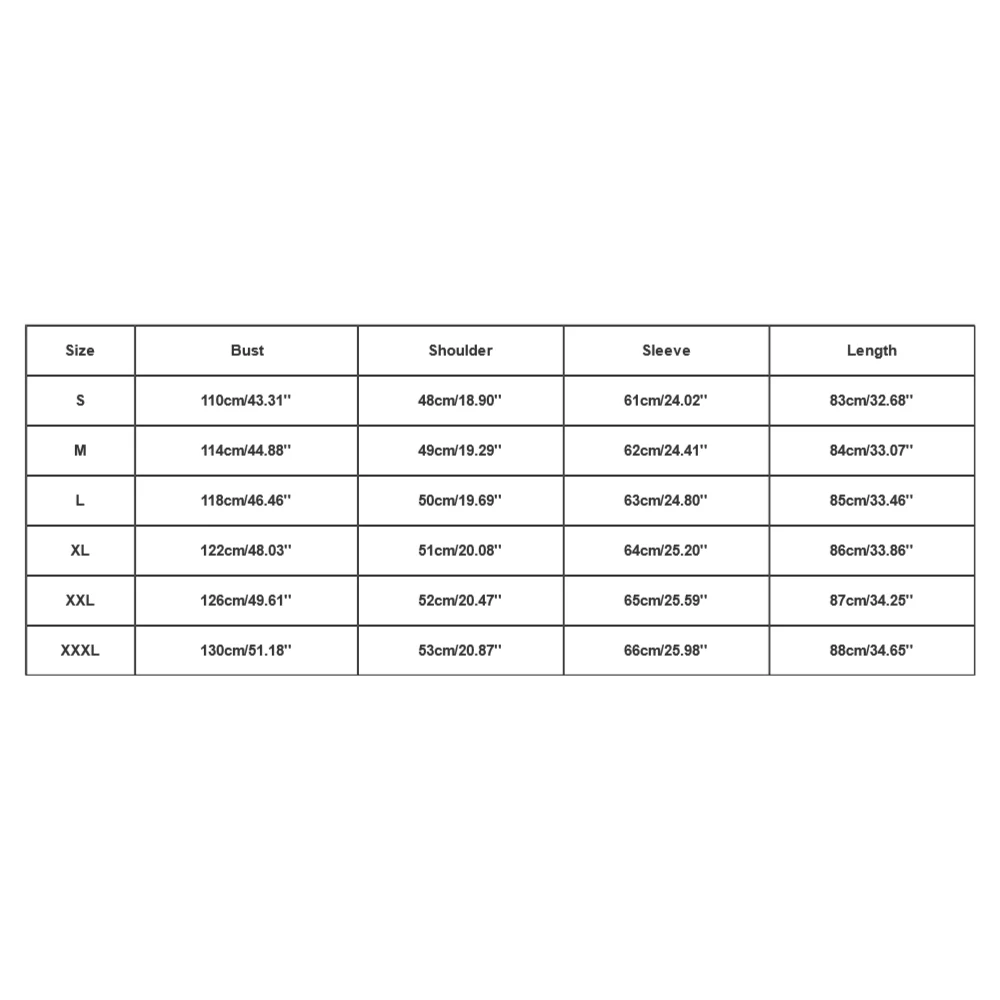
When trying on overcoats, observe how the length affects your overall silhouette. The ideal length creates a balanced appearance between your upper and lower body while complementing your natural proportions. This visual harmony contributes significantly to the overcoat’s versatility across different outfits and occasions.
Versatile Style Options: From Morning Commute to Evening Outings
The style details of your grey overcoat determine how seamlessly it transitions between different daily scenarios. Certain designs naturally lend themselves to versatility, while others may limit your coat’s adaptability.
The single-breasted overcoat with notch lapels represents the most versatile daily wear option. This classic design pairs equally well with business attire and casual weekend wear. The clean front creates a streamlined appearance that never looks overdressed or underdressed, regardless of your outfit underneath. For maximum versatility, look for models with three buttons, allowing you to adjust the opening based on weather and formality.
Double-breasted overcoats offer a more distinctive appearance with their overlapping front panels and six-button configuration. While slightly more formal, a well-designed double-breasted coat in mid-gray can still work for daily wear when styled appropriately. The additional fabric provides superior wind protection for cold-weather commuting—a practical benefit beyond aesthetics.
Lapel design significantly influences versatility. Notch lapels offer the most adaptable option, working seamlessly across formality levels. Peak lapels add drama and formality—beautiful but potentially limiting for casual settings. The often-overlooked Ulster collar provides exceptional practicality for daily wear, as it can be turned up against the elements without looking awkward or affected.
Pocket configurations balance style and function. Flap pockets provide secure storage while maintaining a clean line. Patch pockets add a casual touch that works beautifully with casual grey overcoats. The ticket pocket (a smaller pocket above the right main pocket) adds visual interest without compromising versatility.
For maximum daily adaptability, consider coats with minimal pattern and restrained details. Solid greys in medium shades offer the greatest styling flexibility. If you prefer some visual texture, herringbone or subtle twill patterns add interest without limiting versatility.
Contemporary interpretations of classic styles often provide the best balance for modern daily wear. The car coat, ending at mid-thigh, offers excellent mobility for active lifestyles. The modern Chesterfield, with its cleaner lines and lighter construction, transitions beautifully between business and casual contexts. The Balmacaan, with its relaxed fit and raglan sleeves, provides exceptional comfort for all-day wear.
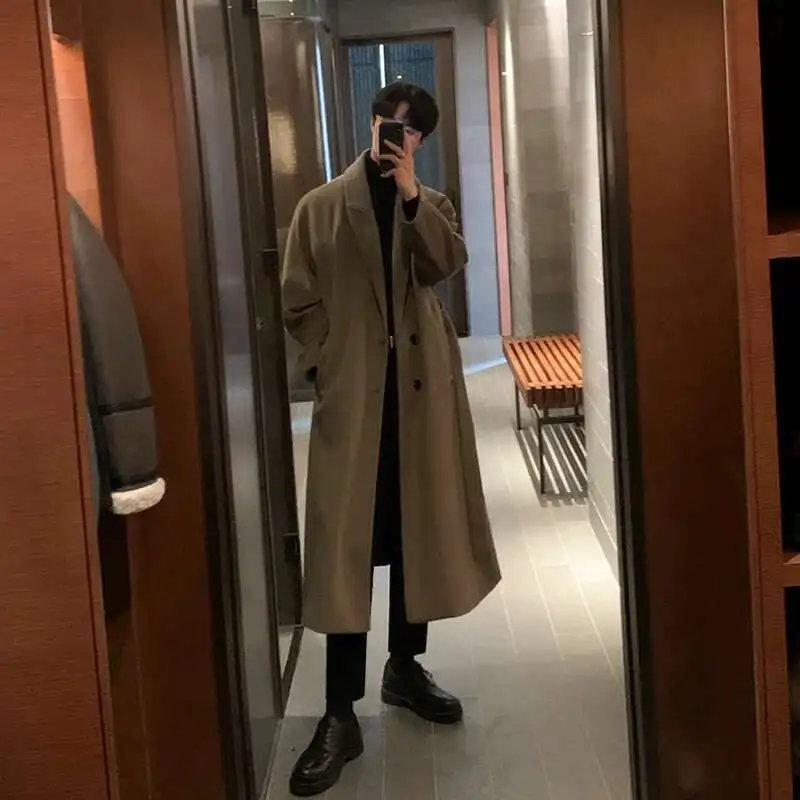
Practical Features That Make Daily Wear Effortless
Beyond material, fit, and style, specific practical features can dramatically enhance your grey overcoat’s functionality for everyday use. These thoughtful details often separate truly exceptional daily wear coats from those that merely look good.
Pocket design deserves careful consideration for daily practicality. Look for deep, reinforced side pockets that can safely carry everyday items without sagging or stretching. An interior breast pocket provides secure storage for valuables like wallets and phones, protecting them from both theft and weather. The most practical daily coats often include an additional interior pocket specifically sized for modern smartphones.
Closure systems balance security with convenience. For maximum versatility, look for buttons that fasten smoothly but securely—horn buttons offer both durability and sophistication. Some practical designs include a hidden placket that covers the buttons for a cleaner appearance while adding an extra layer of wind protection. The placement of the top button is crucial; it should allow the collar to close comfortably around your neck when fully buttoned.
Quality vents enhance daily comfort substantially. A single back vent provides basic mobility, while double vents offer superior freedom of movement and prevent the coat from bunching when you put your hands in your pockets or sit down—a significant advantage during commutes. Center vents can provide easier access to trouser pockets, a practical consideration for daily use.
Weather protection features become essential for true everyday functionality. Storm flaps, throat latches, and wind guards might seem like minor details, but they make a tremendous difference during inclement weather. A well-designed collar that can be turned up and secured against the elements transforms a handsome coat into a practical daily companion.
Construction details like reinforced buttonholes and bar tacking at stress points dramatically extend a coat’s lifespan under daily wear conditions. Similarly, hanging loops designed to support the coat’s full weight prevent warping when hung during the workday.
For those seeking maximum everyday functionality, long overcoats with thoughtful practical features offer exceptional protection and convenience without sacrificing style. These carefully considered elements ensure your overcoat performs as well as it looks throughout years of daily use.
Shades of Grey: Selecting the Most Versatile Hue for Your Wardrobe
Grey overcoats span a remarkable spectrum of shades, each offering different advantages for daily wear. Your selection should complement both your existing wardrobe and your personal coloring.
Medium grey represents the most versatile option, harmonizing effortlessly with virtually any color combination. This middle-of-the-spectrum choice disguises minor soiling better than lighter shades while creating less stark contrast than darker options. For maximum daily versatility, a true medium grey in a matte finish adapts beautifully across formality levels and lighting conditions.
Charcoal grey offers sophisticated depth while maintaining versatility. Slightly more formal than medium grey, charcoal excels in professional settings and evening wear. It pairs exceptionally well with navy, burgundy, and forest green—common colors in business wardrobes. The darker tone also provides practical advantages, showing less daily soil and creating a slimming visual effect.
Light grey brings distinctive sophistication but demands more careful maintenance for daily use. This elegant option creates beautiful contrast with dark business wear and adds refreshing brightness to winter wardrobes. However, it shows soil more readily than darker alternatives, requiring more frequent cleaning. For those willing to provide additional care, light grey offers a refined daily option.
Beyond solid colors, subtle patterns in grey provide practical benefits for daily wear. Herringbone coats disguise minor soiling through their textural pattern while adding visual interest. Glen plaids combining grey with subtle blue or burgundy undertones create versatile options that coordinate beautifully with those colors in your wardrobe.
Your skin tone should influence your grey selection. Warmer skin tones typically harmonize better with greys that have subtle brown undertones (often called “taupe-greys”). Cooler complexions generally pair well with blue-based greys. This harmonization creates a more natural, flattering appearance during daily wear.
Consider your existing wardrobe when selecting grey shades. If you typically wear warm colors like burgundy, camel, or olive, choose greys with warmer undertones. If your wardrobe features cooler colors like navy, blue, or purple, select greys with cooler undertones for maximum coordination.
Five Essential Grey Overcoat Categories for Different Daily Needs
Based on different lifestyle requirements, these five distinct grey overcoat categories offer specialized solutions for various daily wear scenarios.
The Classic Commuter
This category prioritizes durability and weather protection for daily urban travel. Look for medium-weight wool (20-24 oz) with water-resistant treatment that can withstand light precipitation without damage. Key features include secure interior pockets for valuables during commutes, durable button closures that won’t loosen with frequent use, and a length that provides adequate coverage without restricting movement on public transportation. This coat typically features a clean, minimalist design that pairs easily with both business and casual attire. Expect to invest $300-600 for quality versions that will withstand years of daily commuting.
The Business Professional
Designed for those who require consistent professional presentation, this category emphasizes refined appearance while maintaining practical function. Premium wool or wool-cashmere blends (90/10 or 80/20) provide sophisticated drape and comfort during long workdays. A structured shoulder creates a sharp silhouette over business attire, while the typical knee-length design offers traditional professional appearance with practical coverage. Quality versions feature high-grade linings that resist wear from daily putting on and taking off over suits. This investment piece typically ranges from $500-1000, reflecting its premium materials and construction.
The Weekend Casual
This increasingly popular category brings overcoat sophistication to casual daily activities. Typically featuring a more relaxed cut to accommodate casual layering, these coats often utilize textured fabrics like tweed or short vs. long coat styles with a slightly shorter length for increased mobility. Practical patch pockets provide easy access during active weekend wear. The relaxed styling pairs perfectly with jeans, chinos, and casual footwear. This versatile category typically ranges from $250-500, offering excellent value for weekend flexibility.
The All-Weather Performer
Designed for those who face varied climate challenges daily, this specialized category incorporates technical features without sacrificing style. Look for wool-synthetic blends with advanced weatherproofing or bonded wool construction that provides wind and water resistance. Thoughtful features include removable liners for temperature adaptation, sealed seams to prevent moisture penetration, and collars designed to protect against wind and rain. These technical advantages typically come at a premium ($400-800) but provide exceptional functionality in challenging conditions.
The Minimalist Modern
This contemporary category emphasizes clean lines and versatile styling for the modern wardrobe. Typically featuring slimmer proportions without appearing tight, these coats often utilize lighter-weight wools (16-20 oz) that accommodate layering without bulk. The simplified design—often without back vents or with minimal detailing—creates a distinctly modern aesthetic that transitions seamlessly between casual and semi-formal contexts. This increasingly popular category ranges from $300-700 depending on material quality and construction.
Mens Black Overcoat, Mens Black Wool Coat, Mens Wool Overcoat
$339.18 Select options This product has multiple variants. The options may be chosen on the product pageMens Grey Overcoat, Mens Wool Blend Coat, Mens Wool Overcoat
$201.28 Select options This product has multiple variants. The options may be chosen on the product pageMens Herringbone Coat, Mens Long Overcoat, Mens Wool Overcoat
Price range: $197.16 through $203.69 Select options This product has multiple variants. The options may be chosen on the product pageMens Long Overcoat, Mens Topcoats
Price range: $189.40 through $196.88 Select options This product has multiple variants. The options may be chosen on the product pageMens Long Overcoat, Mens Tweed Coat
Price range: $397.49 through $409.96 Select options This product has multiple variants. The options may be chosen on the product pageMens Black Overcoat, Mens Long Overcoat
Price range: $100.12 through $173.24 Select options This product has multiple variants. The options may be chosen on the product page
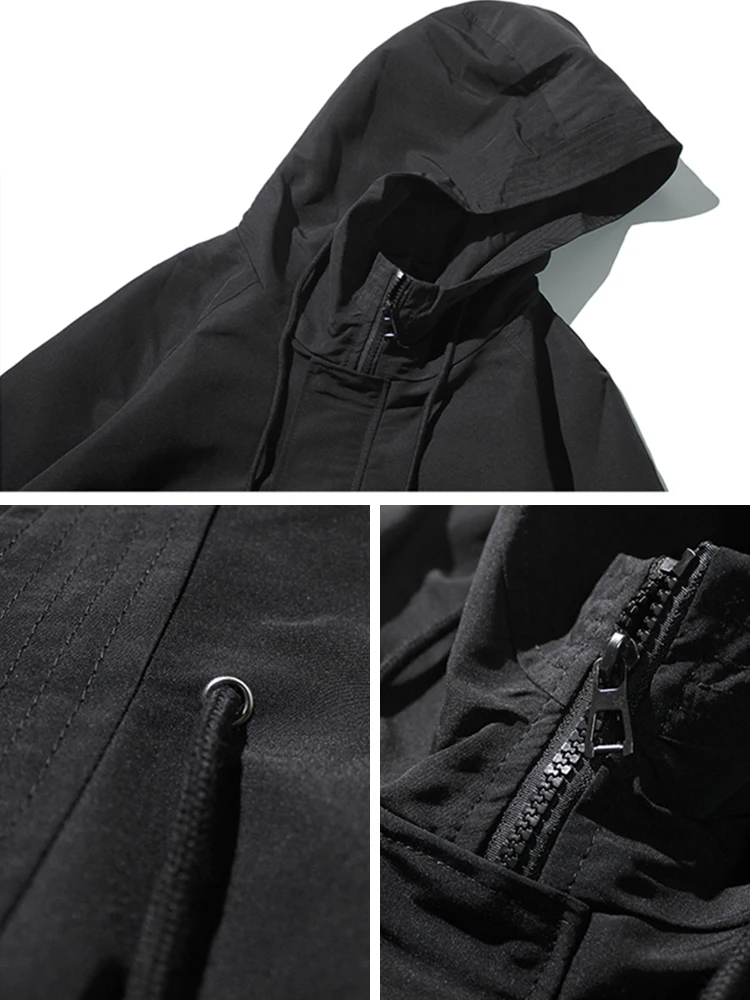
Styling Your Grey Overcoat: From Casual to Business Casual
The remarkable versatility of a grey overcoat reveals itself through thoughtful styling. With the right combinations, your coat easily adapts to virtually any daily scenario.
For weekend casual outings, pair your grey overcoat with dark jeans, a simple crew neck sweater, and clean sneakers or casual boots. This effortless combination creates a smart-casual look that works perfectly for coffee outings, casual dining, or weekend errands. A textured scarf adds both warmth and visual interest without appearing overdressed.
Smart-casual work environments call for more refined pairings. Combine your grey coat with chinos or wool trousers, a button-down shirt, and a fine merino or cashmere sweater. Complete the look with Chelsea boots or leather sneakers. This balanced approach signals professionalism while maintaining comfortable accessibility appropriate for creative workplaces or casual Fridays.
Business casual settings benefit from slightly more structured combinations. Wear your overcoat over wool trousers, a quality button-down, and a blazer or sports coat. Leather dress boots or loafers complete this versatile look that transitions seamlessly from office to evening engagements. A pocket square adds a touch of personality without excessive formality.
Color coordination significantly impacts the versatility of your grey overcoat. Medium and charcoal greys pair beautifully with navy, burgundy, forest green, and most earth tones. Lighter greys create striking combinations with darker colors like black, navy, and deep burgundy. For a sophisticated monochromatic look, pair different shades of grey for subtle depth.
Layering becomes both practical and stylish with grey overcoats. In milder conditions, light layers like merino sweaters provide adequate warmth. As temperatures drop, add vests or lightweight jackets between your shirt and overcoat. This approach not only enhances warmth but also creates visual depth that elevates your overall appearance.
Accessories dramatically influence how your grey overcoat is perceived. A colorful scarf instantly adds personality to an otherwise subdued outfit. Leather gloves in brown or burgundy introduce warmth and sophistication. For maximum versatility, choose accessories in complementary colors rather than exact matches, creating harmonious combinations rather than rigid uniformity.
Your Buying Checklist: How to Evaluate Quality and Fit
Before making this significant investment, use this comprehensive checklist to ensure you select a grey overcoat that will serve you beautifully through years of daily wear.
Material Assessment
- Run your hand against the fabric—quality wool should feel smooth in one direction and slightly resistant in the other
- Check for consistent color throughout, without obvious fading or irregularities
- Examine the weight—it should feel substantial but not excessively heavy
- For wool coats, look for clear fiber information (ideally 100% wool or specified wool blends)
- Quality wool overcoats for winter warmth should drape smoothly without excessive wrinkling
Fit Verification
- Shoulders should align with or extend just slightly beyond your natural shoulder line
- With arms at sides, sleeves should reach the base of your thumb
- Button the coat—it should close comfortably without pulling or gaping
- The collar should sit flat against your neck without buckling
- When wearing typical layers underneath, you should be able to comfortably cross your arms
- Back and side vents should remain closed when standing normally
- Length should hit at an intentional point (mid-thigh, knee, or below knee) rather than an awkward in-between
Construction Quality
- Examine buttonholes for tight, consistent stitching
- Check that pattern matching occurs at seams (particularly noticeable on herringbone or plaid)
- Lining should be smoothly attached without puckering or loose threads
- Pockets should be reinforced at stress points
- Interior seams should be clean, finished, and secure
- Buttons should be securely attached with reinforcement backing
Practical Considerations
- Verify pocket depth is sufficient for your typical items
- Check that interior pockets close securely
- Ensure the coat isn’t excessively heavy for daily commuting
- Consider maintenance requirements based on fabric content
- Evaluate the return policy and warranty coverage
Value Assessment
- Research similar coats to ensure pricing is appropriate for quality level
- Consider cost-per-wear based on your climate and wearing habits
- Balance immediate budget constraints with long-term durability expectations
- Recognize diminishing returns at very high price points
This methodical evaluation process helps ensure your grey overcoat investment delivers maximum daily wear satisfaction. Take your time with this assessment—a well-chosen coat will serve you for many years.
Care and Maintenance: Protecting Your Grey Overcoat Investment
Proper care dramatically extends the lifespan of your grey overcoat, preserving its appearance and functionality through years of daily wear.
Regular Maintenance
Brush your overcoat after each wearing with a proper garment brush, using gentle downward strokes to remove surface dust and debris. This simple habit prevents particles from embedding in the fabric. Pay special attention to the collar, cuffs, and front panels that collect the most soil. For wool coats, use a natural bristle brush; for synthetic blends, a softer brush prevents surface abrasion.
Allow your coat to air out for at least 24 hours between wearings. This simple practice prevents odor buildup and allows natural fibers to recover their shape. Use proper wooden or plastic hangers with adequate shoulder support rather than wire hangers that can distort the coat’s shape over time.
Spot Cleaning
Address spills immediately to prevent staining. For water-based spills on wool, blot (don’t rub) with a clean, dry cloth to absorb moisture, then allow to air dry. For oil-based spots, apply a small amount of talcum powder to absorb the oil, let it sit for several hours, then brush away. Always test any cleaning solution on an inconspicuous area first.
For stubborn spots on grey wool, a solution of mild wool detergent and cool water can be dabbed on the area, then blotted dry with a clean cloth. Avoid circular rubbing motions that can damage the fabric’s surface and create obvious clean spots.
Professional Cleaning
Most quality overcoats should be professionally dry cleaned only when genuinely soiled, typically once per season with regular wear. Excessive cleaning can break down natural fibers and remove the fabric’s natural oils. When seeking professional cleaning, choose establishments experienced with fine outerwear and specify any areas requiring special attention.
Storage
Proper off-season storage significantly extends your coat’s lifespan. Before storing, ensure your coat is clean and completely dry. Use breathable garment bags rather than plastic, which can trap moisture and lead to mildew. Cedar blocks or lavender sachets serve as natural moth deterrents without the harsh chemicals of mothballs.
Store in a cool, dry place away from direct sunlight, which can fade grey fabrics over time. If space allows, laying the coat flat puts less stress on the shoulders and construction than hanging for months.
Repair and Refresh
Address minor issues promptly before they develop into major problems. Loose buttons should be resewn at the first sign of movement. Small tears can often be rewoven by specialized services if caught early. For worn areas like cuffs or collar edges, professional reinforcement can prevent further deterioration.
When to Splurge vs. Save: Budget Considerations for Daily Wear Overcoats
Investing in a quality grey overcoat requires balancing immediate budget constraints with long-term value. Understanding where to allocate your resources ensures maximum satisfaction with your purchase.
Worth the Splurge
Material quality justifies higher investment for daily wear. Premium wool with a high thread count resists pilling, maintains its appearance, and provides superior insulation—qualities you’ll appreciate daily. The difference between an 80% and 100% wool coat becomes apparent after months of regular wear, making this a worthwhile splurge.
Construction details that affect longevity merit additional investment. Hand-stitched button reinforcement, quality seam construction, and properly installed linings significantly extend a coat’s useful life. These hidden elements make the difference between a coat that lasts three years versus ten years of daily wear.
The internal structure—canvas, chest piece, and shoulder construction—directly impacts how the coat drapes and maintains its shape through regular use. These invisible elements justify higher pricing in premium coats and deliver tangible benefits for daily wearers.
Smart Savings
Style details offer opportunities for sensible savings. Trendy features that might look dated in a few years don’t justify significant price premiums. Similarly, extremely distinctive styling may limit versatility—a consideration for daily wear pieces that should coordinate with multiple outfits.
Brand premiums sometimes exceed actual quality differences. Research construction methods and materials rather than relying solely on designer names. Many mid-tier manufacturers produce excellent daily wear coats at substantially lower prices than luxury brands using comparable materials.
Timing purchases strategically creates exceptional value. End-of-season sales often reduce prices by 30-50% on quality overcoats. While this requires patience, the savings can allow access to significantly higher quality than would otherwise fit your budget.
Value Thresholds
For 100% wool daily wear overcoats, significant quality improvements typically occur around the $300 mark. Below this threshold, compromises in wool quality or construction become more common. The $300-600 range often represents the optimal value balance for most daily wearers, with improvements in material refinement and construction detail.
Above approximately $800, improvements become more subtle and sometimes focus on brand prestige rather than functional benefits. While these premium coats offer exquisite details and materials, the practical advantages for daily wear may not justify the additional investment for most buyers.
Questions to Consider: Is This Grey Overcoat Right for Your Daily Life?
Before finalizing your selection, reflect on these practical questions to ensure your chosen grey overcoat truly aligns with your daily needs and lifestyle.
Lifestyle Compatibility
How does your typical commute affect your overcoat needs? Car commuters might prioritize wrinkle resistance and shorter lengths, while public transit users or walkers benefit from weather protection and durability in high-contact areas.
What’s your local climate’s temperature range and precipitation pattern? Areas with significant temperature fluctuations throughout the day might benefit from lighter weights that layer easily. Rainy regions require water-resistant treatments or fabrics that dry quickly.
How formal is your typical workplace? Conservative professional environments might call for longer, more structured overcoats, while creative fields allow greater style flexibility.
Wardrobe Integration
What colors dominate your existing wardrobe? Your grey overcoat should harmonize with these colors—warmer greys complement earth tones and burgundies, while cooler greys pair beautifully with blues and jewel tones.
What’s your typical layering approach? If you frequently wear suit jackets or blazers, ensure your overcoat allows adequate room. If you typically wear only shirts or light sweaters, a more fitted coat might be appropriate.
Does your personal style lean traditional or contemporary? This orientation should influence details like length, lapel width, and overall silhouette to ensure your coat feels authentically “you.”
Practical Considerations
How long do you expect this coat to serve you? Longer planned ownership justifies higher investment in timeless styling and quality construction.
Will this be your only overcoat or part of a rotation? If it’s your sole option, versatility becomes paramount. As part of a collection, it can fulfill a more specialized role.
What’s your realistic maintenance capacity? Be honest about your willingness to properly care for your coat—some options require more attentive maintenance than others.
By thoughtfully addressing these questions, you’ll identify the grey overcoat that truly meets your unique daily needs rather than simply following generic recommendations. This personalized approach ensures maximum satisfaction with your investment.
Final Thoughts: Making a Confident Grey Overcoat Selection
A well-chosen grey overcoat transcends mere functionality to become a signature piece that enhances your daily appearance for years. By carefully considering material, fit, length, style, and practical features, you’ve gained the knowledge to select an overcoat that truly meets your unique needs.
Remember that this investment rewards patience and deliberate consideration. Take time to try multiple options, paying special attention to fit across the shoulders and chest—areas that cannot be easily altered. Consider seasonal timing to maximize value, potentially accessing higher quality within your budget.
The perfect daily grey overcoat becomes more than just another garment—it transforms into a trusted companion that protects, flatters, and serves you faithfully through countless daily journeys. With careful selection and proper care, it will remain a wardrobe cornerstone that you’ll reach for with confidence season after season.

